Bahia Grass (Paspalum Notatum) Grow & Care Instruction
Written by Iris
Dec 06 2021
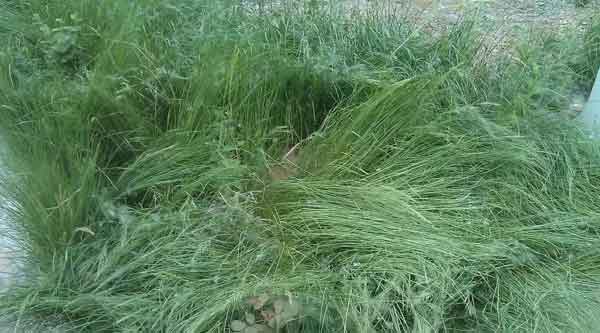
Bahiagrass (Paspalum notatum) is a warm season turfgrass that grows year-round in Louisiana. Bahia Grass can grow in a variety of soil types and is especially suitable for areas with drier soil conditions. Bahia Grass has lower water and nutrient requirements than other warm-season turfgrass varieties. These characteristics make Bahia Grass (Paspalum notatum) a popular choice in areas along roadsides and highways.
Sow bahia grass seeds using a broadcast seeder or throwing them by hand. If you decide to seed your lawn choose a quality see. Pensacola bahia grass has a finer leaf texture and is more cold tolerant than Argentine bahia grass, while Argentine bahia grass is darker green. Apply 1 pound of seed evenly over 100 square feet of lawn. For over-seeding, apply 1/2 pound of seed per 100 square feet, applying only to bare or thin spots. Rake the soil again, covering the seeds with a fine layer of soil. It normally germinates in 10-20 days with 14 days considered the normal germinating time under ideal conditions.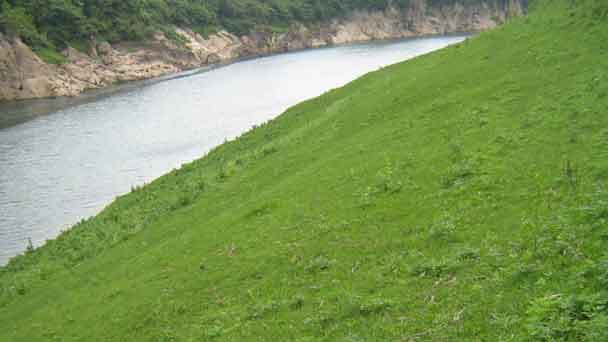
Apply 3/4 to 1 inch of water per application. This will apply water to roughly the top 8 inches of soil, where the majority of the roots are.
During prolonged droughts, irrigation may be needed more often. Bahia grass has the best drought tolerance of all lawn grasses grown in Florida and will usually recover from severe drought injury soon after rain or irrigation. It is very important not to over water Bahia grass lawns as this weakens the turf and encourages weeds.
During extended periods of drought, bahia grass may go dormant if left without irrigation. The grass will turn brown and stop growing during this dormant period, but will revive and resume growth upon regular application of water.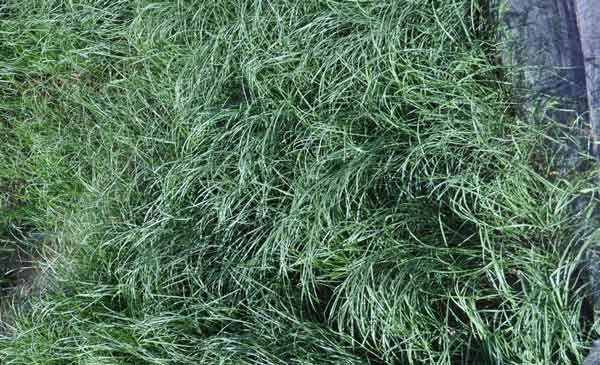
If you suspect you have crickets burrowing into the soil, apply 2 gallons of water mixed with 1 to 2 ounces of detergent soap per 2 square feet to the damaged area. This will flush out any mole crickets that are around.
Insecticides for mole crickets are constantly changing, but bait-type insecticides seem to work best.
Mole crickets can frequently burrow itself in the soil of bahia grass
Occasionally, bahia grass is affected by the dollar spot fungal disease. It will appear as large brown spots on the leaves.
The disease is usually caused by nitrogen deficiency. So, as long as you’re fertilizing your lawn correctly, this should not be an issue.
If the spots do show up on your lawn, a light dusting of 8 ounces of nitrogen per 1,000 square feet should remedy the problem.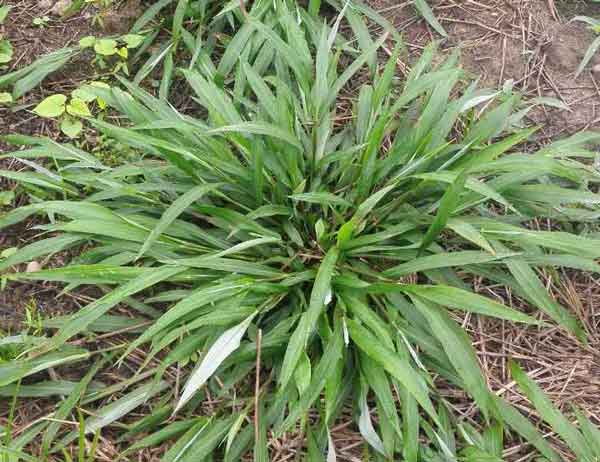
Argentine Bahiagrass: This cultivar forms a dense turf and with dark green blades, making it an attractive lawn covering. An established lawn usually crowds out most weeds. It grows deep roots, which enhances drought tolerance. Few diseases or insects affect the Argentine variety.
Pensacola Bahiagrass: The Pensacola cultivar forms a turf with longer and narrower leaf blades than Argentine. It also tolerates cold temperatures better than Argentine. However, it produces noticeably more seed heads than the Argentine variety. This reduces its desirability as a lawn turf, but makes it more desirable as a pasture grass.
Tifton-9 Bahiagrass: A fine-blade bahiagrass cultivar with a high cold tolerance. It grows fast and establishes seeds quickly. Commonly used in more northern climates as erosion control along roadways and in pastures due to its high forage percentage.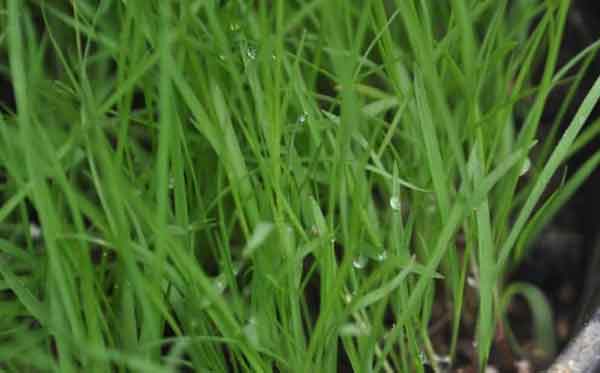
When to Grow Bahia GrassHow to Grow Bahia GrassHow to Care for Bahia GrassBahia Grass Lighting RequirementsBahia Grass Soil CareBahia Grass WateringBahia Grass Temperature & Humidity CareBahia Grass FertilizerBahia Grass Pruning Bahia Grass Pests & Diseases CareBahia Grass VarietiesBahia Grass Care FAQHow Long Does It Take Bahiagrass to Grow?How Do I Make My Bahia Grass Thicker?
When to Grow Bahia Grass
The best time to sow bahia grass seed is in the spring and early summer. You can also sow in the fall, but the seed will not germinate until the spring, and growth will be reduced. The most important factor is that the soil be warm; bahia grass will not germinate in cold soil.How to Grow Bahia Grass
Due to its popularity, many home improvement stores and nurseries in the bahiagrass-growing regions of the country carry either sod or seed. The advantages of planting sod include rapid establishment and fewer weeds. Starting a lawn from seed generally costs less than sod and it uses far less labor, however, seed takes longer to become established.Sow bahia grass seeds using a broadcast seeder or throwing them by hand. If you decide to seed your lawn choose a quality see. Pensacola bahia grass has a finer leaf texture and is more cold tolerant than Argentine bahia grass, while Argentine bahia grass is darker green. Apply 1 pound of seed evenly over 100 square feet of lawn. For over-seeding, apply 1/2 pound of seed per 100 square feet, applying only to bare or thin spots. Rake the soil again, covering the seeds with a fine layer of soil. It normally germinates in 10-20 days with 14 days considered the normal germinating time under ideal conditions.

How to Care for Bahia Grass
Bahia Grass Lighting Requirements
Being well-suited for southern climates, bahiagrass (Paspalum notatum) thrives in full sun exposure. It is not a fan of shaded areas.Bahia Grass Soil Care
Bahia grass thrives in soil that many lawn varieties struggle with. It is an ideal selection for poor, sandy soils that are low in nutrients. When it comes to soil pH, acidic soil is a must for this grass. Neutral or alkaline soil can cause problems such as iron deficiency.Bahia Grass Watering
Irrigating as needed is the best way to water any established, mature grass, as long as the proper amount of water is applied when needed. Irrigation is needed when leaf blades begin to fold up, wilt, or turn blue-gray in color, or when footprints remain visible after walking on the grass.Apply 3/4 to 1 inch of water per application. This will apply water to roughly the top 8 inches of soil, where the majority of the roots are.
During prolonged droughts, irrigation may be needed more often. Bahia grass has the best drought tolerance of all lawn grasses grown in Florida and will usually recover from severe drought injury soon after rain or irrigation. It is very important not to over water Bahia grass lawns as this weakens the turf and encourages weeds.
During extended periods of drought, bahia grass may go dormant if left without irrigation. The grass will turn brown and stop growing during this dormant period, but will revive and resume growth upon regular application of water.

Bahia Grass Temperature & Humidity Care
Bahiagrass (Paspalum notatum) is tolerant of many harsh conditions, including heat. Though this grass does not require large amounts of water, high humidity provides great moisture for this grass to thrive. The deep South and Gulf coast areas perfectly match the ideal growing conditions for this grass variety.Bahia Grass Fertilizer
As with most turf grass, an annual soil test is the only way the fertilizer needs of a bahia lawn. In general bahiagrass has low fertility requirements, which makes it suitable for infertile soils. Nitrogen should be applied at a rate of no more than 1 pound per 1,000 square feet per application. Chlorotic (pale green) blades darken after an application of nitrogen.Bahia Grass Pruning
Bahia grass grows slowly. You only need to cut it every 7 to 14 days while it is actively growing. Mow it to a height of 3 to 4 inches. Taller grass like that will shade the soil and keep it cool and moist. This will encourage deeper root growth. It will also make your lawn look fuller. During dormancy, maintain a grass height of 2 to 4 inches. Otherwise, you will find have seedheads hanging over your lawn.Bahia Grass Pests & Diseases Care
The most common insect causing harm is the mole cricket. It burrows into the soil and damages the roots to the point where the grass will wilt and die.If you suspect you have crickets burrowing into the soil, apply 2 gallons of water mixed with 1 to 2 ounces of detergent soap per 2 square feet to the damaged area. This will flush out any mole crickets that are around.
Insecticides for mole crickets are constantly changing, but bait-type insecticides seem to work best.
Mole crickets can frequently burrow itself in the soil of bahia grass
Occasionally, bahia grass is affected by the dollar spot fungal disease. It will appear as large brown spots on the leaves.
The disease is usually caused by nitrogen deficiency. So, as long as you’re fertilizing your lawn correctly, this should not be an issue.
If the spots do show up on your lawn, a light dusting of 8 ounces of nitrogen per 1,000 square feet should remedy the problem.

Bahia Grass Varieties
Common Bahiagrass: The original Brazilian cultivar grows unevenly spaced clumps of coarse-textured light-colored blades. A close cut exposes bare spots of soil between the grass patches. It holds up well under moderate grazing pressure. Older pastures may contain common bahiagrass, but over time, modern cultivars largely replaced it.Argentine Bahiagrass: This cultivar forms a dense turf and with dark green blades, making it an attractive lawn covering. An established lawn usually crowds out most weeds. It grows deep roots, which enhances drought tolerance. Few diseases or insects affect the Argentine variety.
Pensacola Bahiagrass: The Pensacola cultivar forms a turf with longer and narrower leaf blades than Argentine. It also tolerates cold temperatures better than Argentine. However, it produces noticeably more seed heads than the Argentine variety. This reduces its desirability as a lawn turf, but makes it more desirable as a pasture grass.
Tifton-9 Bahiagrass: A fine-blade bahiagrass cultivar with a high cold tolerance. It grows fast and establishes seeds quickly. Commonly used in more northern climates as erosion control along roadways and in pastures due to its high forage percentage.

Bahia Grass Care FAQ
How Long Does It Take Bahiagrass to Grow?
Like many warm-season kinds of grass, it takes a while for Bahiagrass (Paspalum notatum) to establish and germinate. Bahiagrass normally takes about 28 days (4 weeks) to germinate. Since it establishes slowly, it is susceptible to weeds before germination. However, Bahiagrass has a long and dense root system so it can grow in poor soil conditions and handle drought periods very well.How Do I Make My Bahia Grass Thicker?
Bahiagrass will thin out over time, so the best way to maintain a thick Bahiagrass lawn is to overseed it to thicken the turf. The best time to overseed is during the spring, a month or two before the hottest part of the year. Bahiagrass will not grow properly if you try to plant it during the fall as it won’t have time to establish and will dry out during the winter. Bahiagrass will also grow thicker if you keep up a regular watering and fertilizer schedule.Latest Updated
- Benefits of Bugleweed - 7 Science-backed Health Benefits
- Bugleweed Dangers & Side Effects - Is It Poisonous?
- How to Plant Evergreen Trees - What You Should Know
- When to Plant Evergreens - Grow Guide for Evergreen Trees
- 12 Wonderful Evergreen Shrubs for Your Garden
- 12 Popular Evergreen Plants with Pictures for Beginners
- When And How To Prune A Lilac Bush Like a Pro
- How to Grow & Care for Lilac Vine (Hardenbergia Violacea)
- Japanese Lilac Tree (Syringa Reticulata) Care & Propagation Guide
- Shumard Oak Pros and Cons - What to Know
Popular Articles
- Winter maintenance of Antirrhinum Majus
- How to Grow Terminalia Mantaly Tree
- How to Grow and Care for Crossostephium Chinense
- How to grow Antirrhinum Majus in spring
- Peristeria Elata (Dove Orchid) Profile: Info & Care Guide
- Underwatered Snake Plant (Sansevieria Trifasciata) - Signs And How To Fix
- How to Care for Brazilian Jasmine Plant (Mandevilla Sanderi)
- How to Grow & Care for Graptopetalum Purple Delight in Summer
- Rosa Chinensis (China Rose): Plant Growing & Care Tips
- How to Care for Baby Sun Rose (Aptenia Cordifolia)